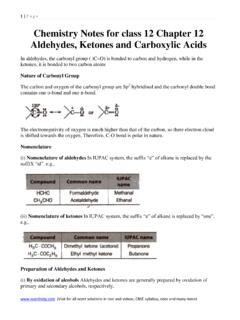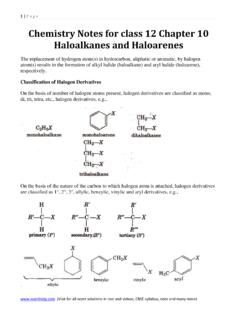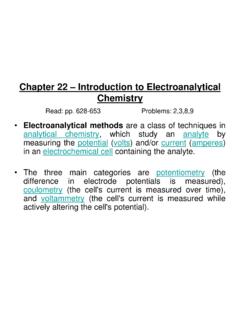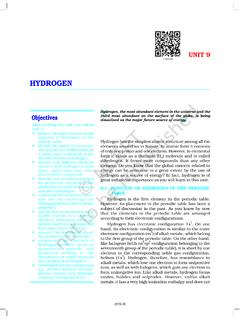Transcription of THE s-BLOCK ELEMENTS - NCERT
1 299 THE s- block ELEMENTSThe s- block ELEMENTS of the Periodic Table are those inwhich the last electron enters the outermost s-orbital. Asthe s-orbital can accommodate only two electrons, twogroups (1 & 2) belong to the s- block of the Periodic 1 of the Periodic Table consists of the ELEMENTS :lithium, sodium, potassium, rubidium, caesium andfrancium. They are collectively known as the alkali are so called because they form hydroxides onreaction with water which are strongly alkaline in ELEMENTS of Group 2 include beryllium, magnesium,calcium, strontium, barium and radium. These elementswith the exception of beryllium are commonly known asthe alkaline earth metals. These are so called because theiroxides and hydroxides are alkaline in nature and thesemetal oxides are found in the earth s crust*.
2 Among the alkali metals sodium and potassium areabundant and lithium, rubidium and caesium have muchlower abundances (Table ). Francium is highlyradioactive; its longest-lived isotope 223Fr has a half-life ofonly 21 minutes. Of the alkaline earth metals calcium andmagnesium rank fifth and sixth in abundance respectivelyin the earth s crust. Strontium and barium have muchlower abundances. Beryllium is rare and radium is therarest of all comprising only 10 10 per cent of igneousrocks (Table , page 299).The general electronic configuration of s- block elementsis [noble gas]ns1 for alkali metals and [noble gas] ns2 foralkaline earth 10 After studying this unit, you will beable to describe the general charact-eristics of the alkali metals andtheir compounds; explain the general characteristicsof the alkaline earth metals andtheir compounds; describe the manufacture,properties and uses of industriallyimportant sodium and calciumcompounds including Portlandcement; appreciate the biologicalsignificance of sodium,potassium, magnesium s- block ELEMENTS *The thin, rocky outer layer of the Earth is crust.
3 A type of rock formedfrom magma (molten rock) that has cooled and first element of alkali and alkaline earth metals differsin many respects from the other members of the group2019-20300 CHEMISTRYL ithium and beryllium, the first elementsof Group 1 and Group 2 respectively exhibitsome properties which are different from thoseof the other members of the respective these anomalous properties they resemblethe second element of the following , lithium shows similarities to magnesiumand beryllium to aluminium in many of theirproperties. This type of diagonal similarity iscommonly referred to as diagonal relationshipin the periodic table. The diagonal relationshipis due to the similarity in ionic sizes and /orcharge/radius ratio of the sodium and potassium ions anddivalent magnesium and calcium ions arefound in large proportions in biological ions perform important biologicalfunctions such as maintenance of ion balanceand nerve impulse 1 ELEMENTS : ALKALIMETALSThe alkali metals show regular trends in theirphysical and chemical properties with theincreasing atomic number.
4 The atomic,physical and chemical properties of alkalimetals are discussed ConfigurationAll the alkali metals have one valence electron,ns1 (Table ) outside the noble gas loosely held s-electron in the outermostvalence shell of these ELEMENTS makes them themost electropositive metals. They readily loseelectron to give monovalent M+ ions. Hence theyare never found in free state in in atomic number, the atom becomeslarger. The monovalent ions (M+) are smallerthan the parent atom. The atomic and ionicradii of alkali metals increase on moving downthe group , they increase in size while goingfrom Li to EnthalpyThe ionization enthalpies of the alkali metalsare considerably low and decrease down thegroup from Li to Cs. This is because the effectof increasing size outweighs the increasingnuclear charge, and the outermost electron isvery well screened from the nuclear Hydration EnthalpyThe hydration enthalpies of alkali metal ionsdecrease with increase in ionic +> Na+ > K+ > Rb+ > Cs+Li+ has maximum degree of hydration andfor this reason lithium salts are mostlyhydrated, , LiCl Physical PropertiesAll the alkali metals are silvery white, soft andlight metals.
5 Because of the large size, theseelements have low density which increases downthe group from Li to Cs. However, potassium islighter than sodium. The melting and boilingpoints of the alkali metals are low indicatingweak metallic bonding due to the presence ofonly a single valence electron in them. The alkalimetals and their salts impart characteristiccolour to an oxidizing flame. This is because theheat from the flame excites the outermost orbitalelectron to a higher energy level. When the excitedelectron comes back to the ground state, thereis emission of radiation in the visible region ofthe spectrum as given below:Alkali metals can therefore, be detected bythe respective flame tests and can bedetermined by flame photometry or atomicabsorption spectroscopy. These ELEMENTS whenirradiated with light, the light energy absorbedmay be sufficient to make an atom lose configurationLithiumLi1s22s1 SodiumNa1s22s22p63s1 PotassiumK1s22s22p63s23p64s1 RubidiumRb1s22s22p63s23p63d104s24p65s1 CaesiumCs1s22s22p63s23p63d104s24p64d105s 25p66s1 or [Xe] 6s1 FranciumFr[Rn] and Ionic RadiiThe alkali metal atoms have the largest sizesin a particular period of the periodic table.
6 WithMetalLiNaKRbCsColourCrimsonYellowVio letRedBlueredviolet s- block ELEMENTSP ropertyLithiumSodiumPotassiumRubidiumCae siumFranciumLiNaKRbCsFrAtomic number31119375587 Atomic mass (g mol 1) (223)Electronic[He] 2s1[Ne] 3s1[Ar] 4s1[Kr] 5s1[Xe] 6s1[Rn] 7s1configurationIonization52049641940337 6~375enthalpy / kJ mol 1 Hydration 506 406 330 310 276 enthalpy/kJ mol 1 Metallic152186227248265 radius / pmIonic radius76102138152167(180)M+ / / K454371336312302 / K161511561032961944 Density / g cm Standard potentials E / V for (M+ / M)Occurrence in18* ** **78-12*2-6*~ 10 18 *lithosphere This property makes caesium and potassiumuseful as electrodes in photoelectric Chemical PropertiesThe alkali metals are highly reactive due totheir large size and low ionization enthalpy. Thereactivity of these metals increases down thegroup.
7 (i)Reactivity towards air: The alkali metalstarnish in dry air due to the formation oftheir oxides which in turn react withmoisture to form hydroxides. They burnvigorously in oxygen forming forms monoxide, sodium formsperoxide, the other metals formsuperoxides. The superoxide O2 ion isstable only in the presence of large cationssuch as K, Rb, (oxide)+ 2222 NaONaO(peroxide)+ 22 MOMO(superoxide)+ (M = K, Rb, Cs)In all these oxides the oxidation state of thealkali metal is +1. Lithium shows exceptionalbehaviour in reacting directly with nitrogen ofair to form the nitride, Li3N as well. Because oftheir high reactivity towards air and water,alkali metals are normally kept in kerosene is the oxidation state of K in KO2?SolutionThe superoxide species is represented asO2 ; since the compound is neutral,therefore, the oxidation state of potassiumis +1.
8 *ppm (part per million), ** percentage by weight; Lithosphere: The Earth s outer layer: its crustand part of the upper mantleTable Atomic and Physical Properties of the Alkali Metals2019-20302 chemistry (ii)Reactivity towards water: The alkalimetals react with water to form hydroxideand + + ++(M = an alkali metal)It may be noted that although lithium hasmost negative E value (Table ), itsreaction with water is less vigorous thanthat of sodium which has the least negativeE value among the alkali metals. Thisbehaviour of lithium is attributed to itssmall size and very high hydration metals of the group react explosivelywith also react with proton donors suchas alcohol, gaseous ammonia and alkynes.(iii)Reactivity towards dihydrogen: Thealkali metals react with dihydrogen atabout 673K (lithium at 1073K) to formhydrides.
9 All the alkali metal hydrides areionic solids with high melting + + (iv)Reactivity towards halogens : The alkalimetals readily react vigorously withhalogens to form ionic halides, M+X .However, lithium halides are somewhatcovalent. It is because of the highpolarisation capability of lithium ion (Thedistortion of electron cloud of the anion bythe cation is called polarisation). The Li+ ionis very small in size and has high tendencyto distort electron cloud around thenegative halide ion. Since anion with largesize can be easily distorted, among halides,lithium iodide is the most covalent innature.(v)Reducing nature: The alkali metals arestrong reducing agents, lithium being themost and sodium the least powerful(Table ). The standard electrodepotential (E ) which measures the reducingpower represents the overall change :2M(s)M(g)sublimationenthalpyM(g)M(g)eio nizationenthalpyM(g)HOM(aq)hydrationenth alpy+ ++ ++ With the small size of its ion, lithium hasthe highest hydration enthalpy whichaccounts for its high negative E value andits high reducing E for Cl2/Cl is + , for I2/I is+ , for Ag+ /Ag is + , Na+ /Na is and for Li+ /Li is Arrangethe following ionic species in decreasingorder of reducing strength:I , Ag, Cl , Li, NaSolutionThe order is Li > Na > I > Ag > Cl (vi) solutions in liquid ammonia: The alkalimetals dissolve in liquid ammonia givingdeep blue solutions which are conductingin nature.
10 33x3yM(xy)NH[M(NH)][e(NH)]+ ++ +The blue colour of the solution is due tothe ammoniated electron which absorbsenergy in the visible region of light and thusimparts blue colour to the solution. Thesolutions are paramagnetic and onstanding slowly liberate hydrogen resultingin the formation of amide. (am)32(am)2 MeNH(1)MNH H(g)+ ++ +(where am denotes solution in ammonia.)In concentrated solution, the blue colourchanges to bronze colour and metal is used to make useful alloys,for example with lead to make white metal bearings for motor engines, with aluminiumto make aircraft parts, and with magnesiumto make armour plates. It is used inthermonuclear reactions. Lithium is also usedto make electrochemical cells. Sodium is usedto make a Na/Pb alloy needed to make PbEt4and PbMe4. These organolead compounds wereearlier used as anti-knock additives to petrol,but nowadays vehicles use lead-free sodium metal is used as a coolant infast breeder nuclear reactors.
















